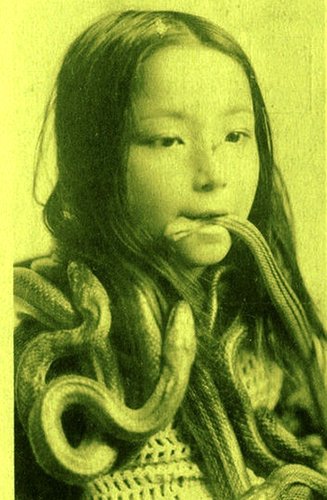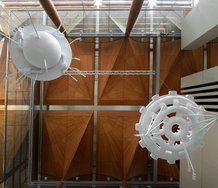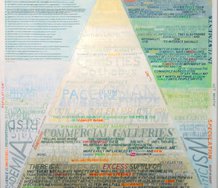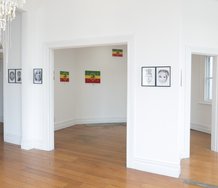Ralph Paine – 19 June, 2019
In an attempt to problematise Crofskey's article, I here offer two brief theory lessons. Both venture into the field of philosophy. Yet in addition, both, I believe, point back to the field of art.
EyeContact Essay #31
Vanessa Crofskey‘s recent The Pantograph Punch article “There’s Something Wrong With Art Writing” is a policing operation; a sad clustering of order-words and clichés; a reductive plea for the collective taking up of a revised Standard Operating Procedure; an exacting yet dismal request that art writing become communicational and informational. In other words, Crokskey wants to normalise art writing, a procedure always involving the simultaneous adoption of a will to pathologise and scapegoat. (1)
However, early on in the article there is mention of Deleuze and Guattari, of how Crofskey once sat at their table, “rigid with desire.” Rigid with desire? What might it be to be rigid with desire? Unyielding by way of flow? Severe amid yearning? Firm in the company of longing? Whatever the case, there’s poetry here, a strange juxtaposition of sense that sets us adrift in puzzlement and wonder. Indeed, Crofskey’s entire account of art school theory class need not be read as reactive and negative: once again, the wistful poetics of her writing (e.g. mouths pressed into the jargon … Edmund Burke’s hovering ghost … concepts stapled to a silhouette) seem firm in the company of longing. She retains, then, a poetico-theoretical experimentation in style and method, yet all the while sets this to use as ideology: the banality of the Like.
In theory class everything seems to change. The initiation into synaesthesia of the studio — along with its singular blends of agency, sensual technique, project — have been swapped for a pared down asceticism and a more contemplative modus operandi. With theory our entire way of proceeding and producing is different: different in intent, different in the form and content of its expression. The initial task of a theory lesson is always the attempted tracking down of these differences, of the digressions they provoke, their myriad byways and paradoxical detours, their twists and turns. But accompanying this, and of equal importance to it, is the related task of suggesting how this enquiry might lead us back into the studio; of showing how — step by step and in all possibility — a theory lesson remains isomorphic to the studio context.
By combining these two spaces or modes of learning we create automatically the field of our adventure — that is to say, the field which accommodates, augments, and composes our thinking and doing. Yet also thereby we create a desire to study the nature of our filigreed relation with practices and theories from outside this field, from other fields (fields of otherness). As artisan-theorists of art we perceive instinctively that by venturing out into these fields — and thus extending our own — we will enrich our artistic lives. And conversely, we are at the same time compelled to ask, for instance, whether geo-engineering websites, philosophical concepts, politico-economic investigation, religious studies texts, or psychoanalytic readings are adequate to the concerns, tasks, and desires of artists. Or do we, and perhaps should we, continue to search for and construct skills, language functions, techniques, styles, and tools distinct from those of other fields? A theory lesson, then, is an effort to think difference: the difference between theory and studio; the difference between the ways of art and other ways. But the lesson is also a vital attempt to think the in-between of these differences, and of how best to travel the intricate and often difficult paths which connect them.
Thus, in an attempt to problematise Crofskey’s article, I here offer two brief theory lessons. Both venture into the field of philosophy. Yet in addition, both, I believe, point back to the field of art.
*****
Field Notes on Deleuze & Guattari‘s A Thousand Plateaus, “Chapter 4. November 20, 1923 - Postulates of Linguistics”
Postulate (noun) “thing claimed or assumed as basis of reasoning, fundamental condition; prerequisite” … (verb) “demand” - Concise Oxford Dictionary
The four standard postulates of linguistics:
I. “Language is Informational and Communicational”
II. “There Is an Abstract Machine of Language That Does Not Appeal to Any ‘Extrinsic’ Factor”
III. “There Are Constants or Universals of Language That Enable Us to Define It as a Homogenous System”
IV. “Language Can Be Scientifically Studied Only Under the Conditions of a Standard or Major Language”
Each of the four postulates is critiqued. A new theory of language is constructed. Or better, a “politics of language” is offered: PRAGMATICS.
The first postulate is critiqued via the concept of the order-word: “Language is made not to be believed but to be obeyed, and to compel obedience.” The order-word is presented as a “language-function, a function coextensive with language.” Order-words are expressions of obedience, assertions, “very short phrases that command life and are inseparable from enterprises and large scale projects: ‘Ready?’ ‘Yes.’ ‘Go ahead.’” The critique then tracks a series of investigations into: 1. Indirect discourse (“indirect discourse is the presence of a reported statement in the reporting statement”). 2. The performative nature of speech acts (J.L. Austin‘s famous theses). 3. Redundancy, a technical term derived from information theory: “Newspapers, news, proceed by redundancy, in that they tell us what we ‘must’ think, retain, expect, etc.” 4. The social character of enunciation. 5. The “instantaneousness” of the incorporeal transformations that the order-word or the language-function carries out.
Towards the end of the critique a line of flight away from all this is conducted via the notion of direct discourse: “Direct discourse is a detached fragment of a mass and is born of the dismemberment of the collective assemblage; but the collective assemblage is always like a murmur from which I take my proper name, the constellation of voices, concordant or not, from which I draw my voice … Speaking in tongues. To write is perhaps to bring this assemblage of the unconscious to the light of day, to select the whispering voices, to gather the tribes and secret idioms from which I extract something I call my Self (Moi).”
The second postulate is critiqued using an adaptation of Hjelmslev‘s form of expression/form of content schema (as introduced in ATP, “Chapter 3. 10, 000 B.C.: Geology of Morals (Who Does the Earth Think It Is?)”). Given any social field, on the horizontal axis there are two “formalizations,” two poles: the “hand-tool pole, or the lesson of things” (content) and the “face-language pole, or the lesson of signs” (expression). The two forms-poles-lessons are independent, heterogeneous yet interpenetrating, that is to say, between the two “a continual passage from one to the other” is occurring, an “interweaving” — the “warp of expressed” and the “woof of bodies,” each with its own form. “When knife cuts flesh, when food or poison spreads through the body, when a drop of wine falls into water, there is an intermingling of bodies; but the statements, ‘The knife is cutting flesh,’ ‘I am eating,’ ‘The water is turning red,’ express incorporeal transformations of an entirely different nature (events).” The genius of the Stoics is cited regarding their theory of language; for an extended analysis of which see: Gilles Deleuze, The Logic of Sense.
“Some general conclusions on the nature of Assemblages” are then drawn, conclusions involving, importantly, the addition of a vertical axis to the above schema, that is to say, the addition of a deterritorializing/reterritorializing functionality (matter/substance). Hence the “tetravalence” of the schema, the between-four-ness of the social field: everything is played out between forms of content, forms of expression, deterritorialized movement, and reterritorialized movement. In conclusion, and contra the second postulate, the abstract machine as it pertains to Assemblages is posited as diagrammatic not linguistic. Hence, the abstract machine is extrinsic to language: “It is language that depends on the abstract machine, not the reverse.”
The third postulate is critiqued using Labov‘s notion of continual variation, which is also named “placing-in-variation.” Variation is inherent to all languages. An analysis of musical variation is then conducted, starting with the mutual presuppositions found operating between “the tonal system” and both atonal and modal music. Jean-Jacques Rousseau is cited positively regarding his proposed Voice-Music relation. On a sound plane that it shares with music, we hear the voice placed-in-variation: “It is perhaps characteristic of secret languages, slangs, jargons, professional languages, nursery rhymes, merchants’ cries, etc. to stand out less for their lexical inventions or rhetorical figures than for the way they effect continuous variations of the common elements of language.” A “generalised chromaticism” is proposed.
Brief accounts of style, stammering, the “AND … AND … AND …” (described as a new form of redundancy), and the “atypical expression” as linguistic tensor follow. In conclusion: “There is therefore no basis for a distinction between a constant and collective language, and variable and individual speech acts. The abstract machine is always singular, designated by the proper name of a group or individual, while the assemblage of enunciation is always collective, in the individual as in the group.”
The fourth postulate is critiqued via an analysis of politics and power: “the scientific model taking language as an object of study is one with the politicized model by which language is homogenized, centralised, standardised, becoming a language of power, a major or dominant language.” The notion of dialect is questioned using a series of contrasting examples: Québecois & Standard French; Bantu, Afrikaans & Standard English; and Black English & Standard English. A theory of major and minor languages as treatments of language is posited: “Major and minor do not qualify as two different languages but rather as two usages or functions of language.”
Positivity now falls to the side of the minor function, that is to say, to the task of making minor treatments. To aid this, a brief account of the notion of minority is presented, culminating with the amazingly productive statement: “In erecting the figure of a universal minoritarian consciousness one addresses powers (puissances) of becoming that belong to a different realm from that of Power (Pouvoir) and Domination.” All this returns with force in ATP, “Chapter 10. 1730: Becoming-Intense, Becoming-Animal, Becoming-Imperceptible …”
Next, Elias Canetti‘s Crowds and Power offers a way of rethinking the order-word, that is to say, of discovering its dual aspect: on the one hand, the order-word is a “death sentence,” yet on the other, it also contains warnings and messages to take flight. This duality is then related back to incorporeal transformations and the intermingling of bodies, that is to say, to the notions of expression and content. Flight away from the standard death sentence is posited as a positivity of becoming, a pushing of language and bodies to their own limits. In order to present the geometrical example of “the smallest difference” in relation to metamorphosis and becoming, an opposition between minor sciences and major sciences is introduced, this reappearing in ATP, “Chapter 12. 1227: Treatise on Nomadology — The War Machine” as nomadic science and Royal Science, respectively. Finally, everything is swept away, synthesized, transformed, caught up once again in the same opera — matter liberated from judgement, the “pass-word” discovered beneath the order-word: “To the answer already contained in a question … one should respond with the questions from another answer.”
*****
Towards Philosophy X
On the whiteboard: X marks this place; a wound
Word playing on the notion of an ownership of place, in Who’s Afraid of Philosophy Jacques Derrida enquires after philosophy as title and deed: “Where is the deed done?” he asks, consequently discovering both ownership and right-action in schools and universities, forums and seminars, lectures, essays, examinations, etc. and thus confirming philosophy as discourse, that is to say, as a practice composed of writing and speech acts, evaluations and judgments, etc., these conducted via the administration of authorized institutional power, including the ongoing power of archives and finance in constructing systematic fields of knowledge. Philosophy-as-discourse is philosophical praxis, a discursive zone of politico-pedagogical action, of often intense participation in intellectual and labour struggles concerning capitalist-state pedagogy and the production and circulation of contemporary forms of knowledge: “Questions of title and right always have a topological dimension. No institution does without a symbolic place of legitimation, even if assigning this place can be overdetermined at the intersection of empirical and symbolic, physico-geographic and ideal givens within a homogenous or heterogeneous space.”(2)
Meanwhile, and without wishing to underdetermine philosophy’s topos-logos connections, there’s always the local hall, park, field, abandoned lot, street, square, plaza, wall, independent media platform (newspaper, journal, website, ‘zine, etc.) and thus philosophy’s institution-seed is quite capable of escape and dispersal. Indeed, philosophy is especially practiced and proficient in leaving and spreading out from academies, schools, and universities in order to transform radically via an occupation/activation of common space. Does, then, philosophy have fundamental requirement of a city? Perhaps, but at best it certainly thinks a city into existence, an Open City, one in which all are free to dwell and pass, to come and go sans papier, free to get it together around problems = X. Around political, economic, artistic, and conceptual problems such as: “Today, what are the best ways-manners-styles of living and dying together?” & “How might we reuse/retool the current assemblages, machines, waste and ruins, language-functions, etc. so as to create and preserve openings for these ways?” In fact, sometimes philosophy seems nothing if not the live figuring-forth of these two intimately entwined questions and their potential answers, a figuring-forth that assigns — and constantly reassigns — its legitimation in a place held unreservedly in-common.
Yet doubtless there exists a third and profoundly different image of philosophy — “image of thought” (3) — one way more esoteric, less inclined toward a “respectable, rational, or reasonable” community. (4) Let’s recall Nietzsche’s outbound journey, his wayward flight from family, Germanic culture, the university, various friendships. On that path we encounter an obscure wanderer (and his shadow), kin of vagabonds and drifters, refugees and vānaprastha, friend of the anomalous ones, the itinerant sages, shamans and witches, of those who shun the commonplace and take to the road, setting vague and solitary courses leading out of the settled (consensual) ground of the city, to its wild edge, fringes of suburbia, to shorelines elsewhere and otherwise, on tracks high and low, twisted, difficult, risky, through hills and tranquil forests, deserts and high plains, down rivers and across vast oceans. And along the way whilst travelling, whilst swept down rivers and alien pathways into regions = X, through xeno-milieus and dreamscapes in the order of heresy, thought itself becomes ungrounded, excessive, dangerous… Deleuze and Guattari in What is Philosophy?: “To think is always to follow the witch’s flight.” (5) Thus rendered hodological, psychological, and affective, now philosophy streams its adventure outside, en plein air, out into the Unlimited, there forming answers to questions never consented to, ways-out never before encountered and endured.
And the return? As the artist Robert Smithson once remarked, “It seems that no matter how far out you go, you are always thrown back on your point of origin.” (6) Yet always this being-thrown-back alters the origin… Dogs barking early one morning, from out of her distant journeying a philosopher returns to the city (any-city-whatever) as the Stranger, with beautifully bloodshot eyes and a head full of magic, smiling, odd clothing, a satchel on her back stuffed with rusty old photographs, ragged notebooks and papers, memory sticks, and this changes everything. Thus philosophy conjures an absolute to-ing and fro-ing, an in-between but also transversal way of figuring questions and answers. Between the foundational and legitimately enclosed spaces of the city, and the smoother trajectories of errant journeying lies philosophy’s ethical concern: if every settled community of thought is haunted by solitary, itinerant thinkers, and every solitary, itinerant thinker dreams the insomniac vision of a just and Open City to return to, how best to make our way (ethos)?
Martin Heidegger compares philosophy to holzwege, forest paths on which we are certain to lose our way. Lao-Tzu speaks of “the Nameless Way” — Dao — an invisible yet non-transcendent life force, self caused and self sustaining. Nietzsche has his Zarathustra say, “I came to my truth in many ways, by many ways … for the way does not exist.” Hegel speaks of philosophy as “a path that makes its own way” and Joseph Dietzgen as “the way of ways that lead nowhere.” Yamamoto Tsunetomo teaches that “if by setting one’s heart right every morning and evening, one is able to live as though her body were already dead, she gains freedom in the Way.” In line with a series of etymological interweaves and remarks on alterity, Luce Irigaray addresses philosophy as “the Way of Love,” a calm and blissful itinerary shaped via the formation of new manners of saying, listening, othering. Edmond Jabès has a character ask, “Where is the way?” “The way is always to be found,” replies his interlocutor. “A white sheet of paper is full of ways.”
⟡ And so it was that the braided ways of philosophy passed through and impelled her everyday life, cresting and falling, swirling, sparkling micro-prospects of composure and composition, variations on habit and routine, sometimes terrifying vortexes of difference held in an awareness of X, poisonous ideas or radical cures, quietly drifting in the Open, in workshops and offices, in classrooms and shaded gardens, on porches and on dense and difficult pages, in bed with a lover, vibrantly alive around dinner tables, in secret reading groups, at desks aquiver in screen-light and the almost imperceptible hum of computers, when and where once again, suddenly an intensely charged current of fresh thought entered her world and resonated.
Ralph Paine
(1) https://www.pantograph-punch.com/post/jargon-art-writing
(2) Jacques Derrida, Who’s Afraid of Philosophy?: Right to Philosophy 1, trans. Jan Plug (Stanford, California: Stanford University Press, 2002) p. 9.
(3) “We can divide philosophers into the kind that are involved in expelling images from thought, and those who believe that thought as such is dependent on images, metaphors, and figures … It is easy to forget that the foundation of the general concept of the image, whether as icon or eidos, belongs to the field of early philosophy.” Peter Sloterdijk, “Image and Perspective: An Experiment in Atmospheric Seeing-Interview with Tim Otto Roth” in Selected Exaggerations: Conversations and Interviews 1993 - 2011, ed. Bernhard Klein, trans. Karen Margolis (Cambridge UK and Malden MA: Polity, 2016) p. 152. The term “image of thought” appears throughout Deleuze’s oeuvre.
(4) Deleuze and Guattari, What is Philosophy? (London & New York: Verso, 1994) p. 41.
(5) Ibid.
(6) Robert Smithson, The Writings of Robert Smithson, ed. Jack Flam (Berkeley: University of California Press, 1996) p. 192.
Recent Comments
John Hurrell
Good spotting Ralph. Tessa is extraordinarily versatile. Excellent too that things are happening with Megan and Mark at The Spinoff. ...
Ralph Paine
Here's a fantastic and remarkably on point Art + Australia Online editorial by Tessa Laird: http://www.artandaustralia.com/online/writing-more-writing
Ralph Paine
III. Yet in the book’s final two “midnight” pages, quite unexpectedly the transdisciplinary spirit of A Thousand Plateaus and Anti-Oedipus ...

 Two Rooms presents a program of residencies and projects
Two Rooms presents a program of residencies and projects Advertising in this column
Advertising in this column



This Discussion has 12 comments.
Comment
Terrence Handscomb, 9:30 a.m. 19 June, 2019 #
Vanessa Crofskey (“There’s Something Wrong With Art Writing” 12/06/19 TPP): ‘Honestly, I don’t even know how to begin with this. I’ve read the paragraph multiple times and I still don’t understand it. Every time I have another go at unpacking what it means, I get hypnotised by a dictionary and have to skip to the finish line before I can google logical antimony’ [downloaded: 19 June, 2019].
I feel for Vanessa, because I also have no idea what “logical antimony” is. I think it’s a type of dyslexia.
It seems that The Pentagram Punch is the new fun place to write and be heard. Of course the young art crowd love it. It’s all about them. With CNZ funding the writers at TPP are actually paid. Does this mean that EC is the only place left where New Zealand art’s unWOKE white male intellectuals can maintain some semblance of power and (yuk!) conceal the hormonal defeat of ageing?
Ralph Paine, 9:27 a.m. 20 June, 2019 #
WTF Terrence??##!! Count me out here: I’m not even vaguely interested in pitting a white, ageing, unwoke & male EyeContact against a rainbowed, young, woke & female Pantograph Punch. In fact, these are exactly the types of categorisation that in my view are to be avoided at all costs.
However, what is not to be avoided at all costs is the step by step assembly of a collective writing machine AGAINST language policing, anti-intellectualism, a will to pathologise and scapegoat, all new forms of Inquisition, etc.
John Hurrell, 10:38 a.m. 21 June, 2019 #
Here is Robert Leonard on the debate generated by Crofskey's article.... https://robertleonard.org/
Ralph Paine, 12:56 p.m. 21 June, 2019 #
Ah, Thank You Jesus! Thank you for all the "lucid explainers" of this world, for those who've "done the hard yards" and really know how to Inform & Communicate.
Leonard’s a gate-keeper from way back and so as much into language policing as Crofskey is, it’s just that he wants a different kinda normal, a more professionally informed one, one wielding a perhaps more nuanced set of order-words.
And why assume a given readership anyhows? Why not dream up some readership yet to come? The space of reception is about as whacky and unpredictable as it gets so why not go with that flow? Which is kinda what artists wanna do, right?
Terrence Handscomb, 4:59 p.m. 22 June, 2019 #
Much of the theory-based art writing of the sort that Vanessa targets is born of intense philosophical training, not the institutional art world training that Robert advocates (above link). Philosophical texts often treat concepts in ways that seem overwrought to non-philosophers; but this is necessary if precise meaning is to be distinguished from imprecise expression. For example, there is an important conceptual difference between the “materials” used by an artist and the “materiality” of their practice. When these two words are used carefully they can signal a nuanced understanding of art. But who outside the philosophical community and a few art insiders and theorists would care? Not many. But that’s exactly how Vanessa clocks up mileage. She’s pissed and people like that. She gets populist RNZ airtime and TPP column-inches to dress up old tropes in kiddie clothes, and then proceed to wind everyone up. It’s hilarious to see art professionals scatter and then distance themselves from her targets and articulate all the reasons why she is wrong.
BTW no one from Robert’s list of “visible” New Zealand art writers makes it to my list of “great” New Zealand art writers – including (my pal) Robert Leonard. Anthony Byrt may indeed be one of New Zealand’s most credentialed art writers but he is not on my list of great New Zealand art writers for a number of reasons; more so now that the names Anthony Byrt and Theo Schoon will be forever coupled in the op-ed from hell.
John Hurrell, 2:58 p.m. 24 June, 2019 #
Here is the RNZ interview Terrence refers to:
https://www.rnz.co.nz/national/programmes/standing-room-only/audio/2018699845/vanessa-crofskey-declares-war-on-art-jargon
John Hurrell, 8:26 p.m. 1 July, 2019 #
Is COMMUNICATION over-rated; are FORUMS a waste of time; is DISCUSSION a ludicrous thing to attempt? Have a read of this: https://thepointmag.com/2019/politics/republic-of-discussion-habermas-at-ninety#refmark-1
Ralph Paine, 9:22 p.m. 2 July, 2019 #
I.
Using my three spaces schema of Towards Philosophy X above, it seems evident that Habermas sits squarely in the first space, i.e. the university, the academy, the place of philosophy-as-discourse, of philosophical praxis, which I depict as a discursive zone of politico-pedagogical action, of often intense participation in intellectual and labour struggles concerning capitalist-state forms of research, training, and the production and circulation of contemporary forms of knowledge.” But Habermas is also a public intellectual, in fact someone who theorised the very emergence and composition (see his book The Structural Transformation of the Public Sphere: An Inquiry into a Category of Bourgeois Society) of what a modern public is and how it should function as an idealized and rational arena of communication (an arena inclusive of mass media: newspapers, magazines, and book markets early on, then with the addition of cinema, radio, television, social media, etc.). Hence Habermas’ Kant thing, the endless determination of the Conditions of Possibility for communication, the laying down of foundations and laws, but ALWAYS as linked to the idea of a universal democratic State. All well and good, until, that is, one figures out that the only universal operating within global capitalism is the Market. In other words, today all nation states (inclusive of their variously configured public spheres) are interconnected models for the realisation of the capitalist axiomatic (private expropriation).
Hence my two other spaces: the common and the outside. The common retains Habermas’ idea of an arena of communication, but, in an acknowledgment that today All of Us (some of whom will definitely not be human) have the potential to participate in the cooperative production of knowledge(s), the common extends the arena out to the planetary level. Or better, the common relays the production of knowledge(s) between the local and the planetary, the regional and the planetary, the local and the regional, etc. In my view Hardt & Negri’s many books provide remarkable analyses and theories about how the multitude (not the public) is constructing the common.
Ralph Paine, 9:24 p.m. 2 July, 2019 #
II.
However, the notion of the outside rejects Habermas entirely. As Deleuze & Guattari put it in their final book What is Philosophy?, “A great deal of innocence or cunning is needed by a philosophy of communication that claims to restore the society of friends, or even of wise men, by forming a universal opinion as ‘consensus’ able to moralise nations, States, and the market.” So rather than a space of communication, the outside is a space of creation, and to attempt to go there is to resist the present by embracing the to-come. In this sense, and contra Hegel, philosophy doesn’t come after. Rather, in D&G’s formulation philosophy (and art) partakes in the creation of a new Earth and a new people. What is Philosophy? is unlike Deleuze and Guattari’s previous texts: there seems no overt affirmation of transdisciplinarity, little positivity of intellectual contagion or cross-pollination between philosophy, art, and science, and remarkably, all previous Deleuzo-Guattarian critiques of the “What is . . . ?” question-form have been set aside to the extent of elevating said form to the status of title. Clearly for them this is a new and extremely bold tactical manoeuvre, a form of Unconditional Resistance. When D&G speak in a classical and somewhat aristocratic manner of “the exclusive right” of philosophers to create concepts, doubtless they go against the contemporary grain. Why? Faced all around with aggressive rivals and brazen attempted takeovers—from sociology and the communication/information sciences to design theory, from logistics and event management to marketing and advertising strategies—Deleuze and Guattari ask philosophers (artists, scientists, all of us) to take heed of what’s at stake, warning of the imminent capture of the three distinctive types of creative thought by capitalist-state apparatuses. Today even the notion of creativity itself seems captured. Against this disastrous possibility, What is Philosophy? establishes a forceful and apposite pedagogy of concept creation by philosophy (and affect-percept creation by art, functive creation by science).
Ralph Paine, 9:26 p.m. 2 July, 2019 #
III.
Yet in the book’s final two “midnight” pages, quite unexpectedly the transdisciplinary spirit of A Thousand Plateaus and Anti-Oedipus seems to return, as if in a shocked realization that the capitalist-state disaster has already occurred and so now, as always, a new Earth is forming, slowly emerging inside the immense suffering and wreckage. And in this radically Untimely scenario (the time of the outside), as the collective “brain” plunges abruptly into a surrounding chaos, what is extracted from the event is “the shadow of a ‘people to come’ . . . mass-people, world-people, brain-people, chaos-people” for whom the distinctions between philosophy, art, and science have become “indiscernible,” the precise nature of concepts, affects-percepts, and functives rendered “undecidable.”
Thus, and to speak now like Giorgio Agamben, on this new Earth the divisions, dichotomies, and contrasts between philosophy, science, and art coincide in the shadow, they fall-together, yet only to reappear deactivated, rendered inoperative, neutralized as powers, functions, communicative procedures, human operations . . . That is to say, not shattered or destroyed, but rather made destitute precisely as work(s)—liberated in order “to allow a different use of them.” Like Agamben’s adored Bartleby, philosophy, science, and art now “prefer not to,” they remain idle, thereby suspending any renewed operation of the state capitalist apparatuses that once governed and controlled them, that once gave them a distinct purpose (the Market), emerging from this suspension as magical whatever-beings in the time of X rising.
Ralph Paine, 8:03 a.m. 5 July, 2019 #
Here's a fantastic and remarkably on point Art + Australia Online editorial by Tessa Laird:
http://www.artandaustralia.com/online/writing-more-writing
John Hurrell, 9:06 a.m. 5 July, 2019 #
Good spotting Ralph. Tessa is extraordinarily versatile.
Excellent too that things are happening with Megan and Mark at The
Spinoff. https://thespinoff.co.nz/art/03-07-2019/introducing-the-spinoff-art/
This country needs more art writers. Real writers who go beyond slurpy public relations for their mates, but who are willing to stick their necks out and be unpopular. The artworld here is still too kissy-kissy.
Participate
Register to Participate.
Sign in
Sign in to an existing account.